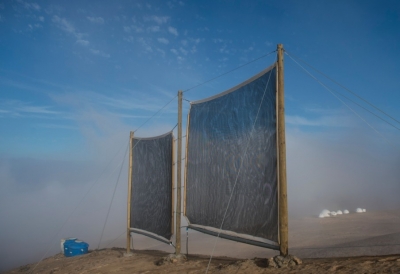
In the hot and dry desert of South Africa, the Namib desert beetle survives by harvesting water from thin air. Droplets of fog accumulate on the bumpy body of the beetle and drip down its wing into its mouth. Similarly, redwood trees of California absorb as much as 40% of their water directly from the fog. Without this adaptation, the trees would not be able to move water from their roots to other parts.
Humans too view fog as an important source of water. Dry and coastal regions around the world rely on fog-filled wind to meet their water needs. They install what are called fog catchers to harvest water suspended in the air. This technique is called fog harvesting or fog catching or fog collection.
Fog catchers are usually constructed in the form of a single or double layer mesh net, stabilised between two posts that are spread out at an angle perpendicular to the wind carrying the fog. As the wind passes through the mesh, drops of freshwater collect on the mesh and run downwards and drip into a gutter at the bottom of the net from where they are channelled via pipes to a storage tank or cistern. Mesh panels can vary in size. Typical water production rates from a fog collector range from 200 to 1,000 litres per day, with variability occurring on a daily and seasonal basis.
Fog harvesting systems are typically installed in areas where the presence of fog is naturally high, typically coastal and mountainous regions. They are erected in open locations with a fairly high elevation that are exposed to wind flow. Meteorological and climatic information such as predominant wind flow direction might have to be gathered to identify optimal placement.
Chile, Peru, Bolivia, Colombia, Mexico and Namibia are some of the countries that have greatly benefited from fog harvesting.
Picture Credit : Google




